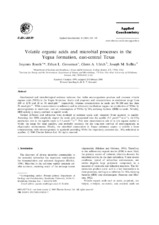| dc.description.abstract | Geochemical and microbiological evidence indicates that viable microorganisms produce and consume volatile organic acids (VOA) in the Yegua formation. Acetic and propionic acid concentrations in mudstones range from 200 to 1270 and 20 to 38 nmol·gdw-1 respectively, whereas concentrations in sands are 50±200 and less than 20 nmol·gdw-1. VOA concentrations in sediments and in laboratory incubations suggest net production of VOAs by microorganisms in mudstones, and net consumption of VOAs by SO4 reducing bacteria (SRB) in sands. Notably, SRB activity is mostly confined to aquifer sands.
Vertical diffusion and advection were modeled to estimate acetic acid transport from aquitard to aquifer. Assuming that SRB completely respire the acetic acid transported into the aquifer (3.2 µmol·l-1·m·a-1), the CO2 production rate in the aquifer sands is 5.3 µmol·l-1·m·a-1. This slow mineralization rate of in situ organic matter is within the range for deep aquifers, and probably accounts for the long-term survival of microorganisms in oligotrophic environments. Finally, the microbial communities in Yegua sediments appear to exhibit a loose commensalism, with microorganisms in aquitards providing VOAs for respiratory processes (i.e., SO4 reduction) in aquifers. © 2000 Elsevier Science Ltd. All rights reserved. | en |


